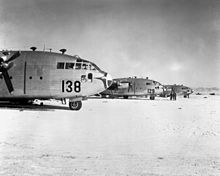Yonpo Airfield: Difference between revisions
m added Empty section (2) tag using AWB |
|||
| Line 43: | Line 43: | ||
On 2 July 1950 the [[19th Bombardment Group]] launched a strike on Yonpo Airfield based on faulty intelligence there were 65 North Korean aircraft there. Only 16 North Korean aircraft were in the field, none of which were damaged by the airstrike. |
On 2 July 1950 the [[19th Bombardment Group]] launched a strike on Yonpo Airfield based on faulty intelligence there were 65 North Korean aircraft there. Only 16 North Korean aircraft were in the field, none of which were damaged by the airstrike. |
||
The Yonpo area was [[UN Offensive, 1950|captured by UN forces]] in October 1950 and the airfield was put into service by the UN forces. The USAF designated the base '''K-27'''.<ref name="Y'Blood">{{cite book|last=Y'Blood|first=William|title=Down in the weeds: Close air support in Korea|publisher=Air Force Historical Studies Office|year=2002|isbn=9781428990173|page=21}}</ref> |
The Yonpo area was [[UN Offensive, 1950|captured by UN forces]] in October 1950 and the airfield was put into service by the UN forces. The USAF designated the base '''K-27'''.<ref name="Y'Blood">{{cite book|last=Y'Blood|first=William|title=Down in the weeds: Close air support in Korea|publisher=Air Force Historical Studies Office|year=2002|isbn=9781428990173|page=21}}</ref> The 35th Fighter-Interceptor Group moved forward to the base in mid-November and provided close air support to the U. S. Army [[X Corps (United States)|X Corps]] and the [[1st Marine Division (United States)|1st U.S. Marine Division]] surrounded at the [[Battle of Chosin Reservoir]]. |
||
USAF units based there included: |
|||
*[[35th Fighter Wing|35th Fighter-Interceptor Group]] from mid-November-7 December 1950, units attached included: |
|||
**[[39th Fighter-Interceptor Squadron]] operating F-51Ds |
|||
**[[40th Fighter-Interceptor Squadron]] operating F-51Ds |
|||
**[[339th Fighter-Interceptor Squadron]] operating F-82Gs |
|||
UN units based there included: |
|||
[[No. 77 Squadron RAAF]] operating F-51Ds attached to the 35th Fighter Wing |
|||
USMC units based there included: |
USMC units based there included: |
||
Revision as of 05:50, 26 June 2013
| Yonpo Airfield Yonpo Air Base | |||||||
|---|---|---|---|---|---|---|---|
 F9F-2 of VF-721 about to attack Yonpo in 1951 | |||||||
| Coordinates | 39°00′59.90″N 125°50′52.90″E / 39.0166389°N 125.8480278°E | ||||||
| Typ | Military airfield | ||||||
| Site information | |||||||
| Owner | Korean People's Air Force | ||||||
| Controlled by | Imperial Japanese Army Air Service Korean People's Air Force United States Air Force | ||||||
| Condition | disused | ||||||
| Site history | |||||||
| Built | 1940s | ||||||
| Built by | Imperial Japanese Army Air Service | ||||||
| In use | 1940s-present | ||||||
| Materials | concrete | ||||||
| Airfield information | |||||||
| |||||||
Yonpo Airfield, also known as Yonpo Air Base or K-27 Air Base, is an airport near Hamhung, South Hamgyong Province, North Korea.
Facilities
This section is empty. You can help by adding to it. (June 2013) |
History
Korean War

On 2 July 1950 the 19th Bombardment Group launched a strike on Yonpo Airfield based on faulty intelligence there were 65 North Korean aircraft there. Only 16 North Korean aircraft were in the field, none of which were damaged by the airstrike.
The Yonpo area was captured by UN forces in October 1950 and the airfield was put into service by the UN forces. The USAF designated the base K-27.[1] The 35th Fighter-Interceptor Group moved forward to the base in mid-November and provided close air support to the U. S. Army X Corps and the 1st U.S. Marine Division surrounded at the Battle of Chosin Reservoir.
USAF units based there included:
- 35th Fighter-Interceptor Group from mid-November-7 December 1950, units attached included:
- 39th Fighter-Interceptor Squadron operating F-51Ds
- 40th Fighter-Interceptor Squadron operating F-51Ds
- 339th Fighter-Interceptor Squadron operating F-82Gs
UN units based there included: No. 77 Squadron RAAF operating F-51Ds attached to the 35th Fighter Wing
USMC units based there included:
UN forces abandoned the base in December 1950 in the face of the Chinese intervention.[2]
See also
This section is empty. You can help by adding to it. (June 2013) |
References
- ^ Y'Blood, William (2002). Down in the weeds: Close air support in Korea. Air Force Historical Studies Office. p. 21. ISBN 9781428990173.
- ^ Futrell, Frank (1983). The United States Air Force in Korea, 1950-1953. Air Force History & Museums Program. p. 263. ISBN 9780912799711.
